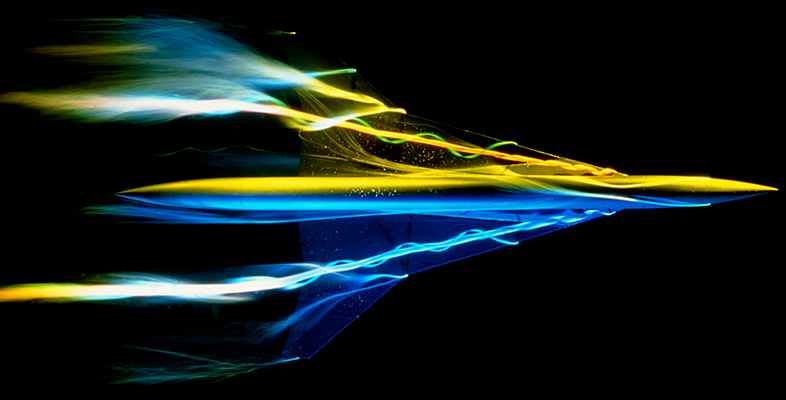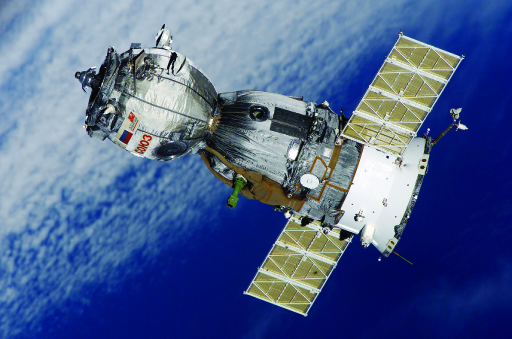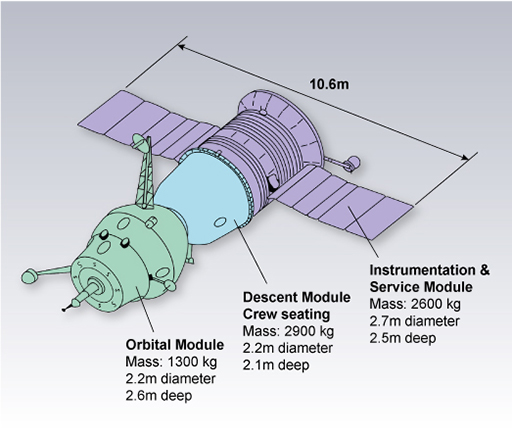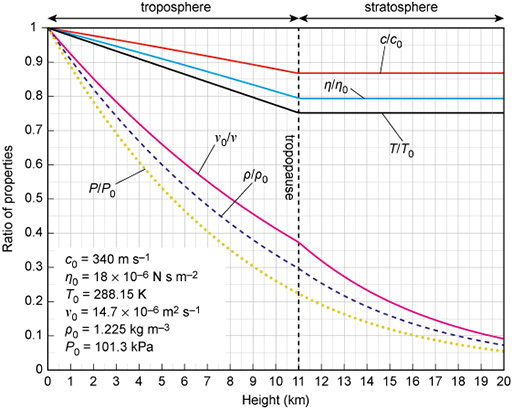1.4 Spacecraft re-entry considerations
The Soyuz spacecraft pictured in Figure 10 comprises three sections: a spherical orbital module, a blunt-ended descent (sometimes called re-entry) module and a service module (see Figure 11).
Before starting the next activity, you may find it interesting to watch the video about Soyuz re-entry produced by the European Space Agency but note that it is not necessary to watch it to undertake the activity.
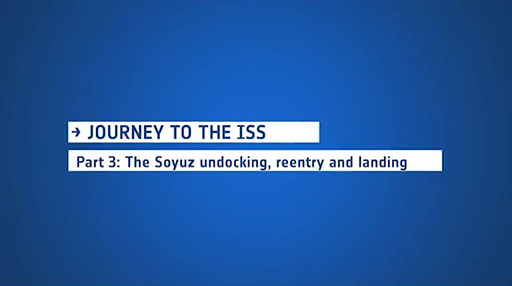
Transcript: Video 1 The Soyuz spacecraft
Activity 9
The Soyuz descent module parachute is activated at an altitude of around 10 km, when the capsule has a velocity of around 900 kph (250 m/s). Using Figure 2 (reproduced here for convenience):
Question 1
(a) The local speed of sound at that height ( 10 km), to 2 s.f. (Note: the line c/co is the ratio of the speed of sound at a given height, c, to the speed of sound at sea level, co).
Find the following:
Answer
From the figure it can be seen that at 10 km the speed of sound ration and it is stated that so the local speed of sound is:
(b) The Mach number, Ma (the ratio of speed to speed of sound) of the capsule when the parachute is deployed.
Answer
Speed of capsule = 250 m/s
Question 2
The capsule is assumed to be at its terminal velocity when the parachute is activated (at an altitude of 10 km). At terminal velocity the aerodynamic drag, Fd, on the capsule is equal to its weight, W, so:
Fd = W = mg, where g is the acceleration due to gravity ( another quantity that varies with altitude, but you can assume to be 9.8 m.s−2)
Aerodynamic drag on capsule is given by
Where Cd is the drag coefficient, ρ is the local air density, u is the velocity of the capsule and A is the cross sectional area of the capsule.
Using data from Figure 2 and from Figure 11, calculate the value of the drag coefficient of the capsule.
Answer
At terminal velocity the weight of the capsule is exactly balanced by its aerodynamic drag, so
by its aerodynamic drag, so
which can be rearranged to find the drag coefficient
From Figure 11, the diameter of the capsule is 2.2 m, so the area is
Also from Figure 11, the mass of the re-entry module is 2900 kg and from Figure 2, the density ratio at 10 km is about 0.34. The density, therefore, is given by,
Substituting in the values gives a drag coefficient of
Question 3
A relatively small braking parachute is initially deployed to slow the capsule down. When the braking parachute has reduced the speed of the capsule to around 80 m/s at a height of 7.5km, the main parachute, which has an area of 1000 m2, is deployed and reduces the capsule speed to a steady 25 kph (6.9 m/s).
Assuming a drag coefficient of 1.7 (this is fairly standard for parachutes), estimate the altitude at which this new terminal velocity will be established. Neglect the contribution to drag of the capsule itself and give your answer to 2 significant figures.
Answer
As before, at terminal velocity the weight of the capsule is exactly balanced by its aerodynamic drag, so
but this time the air density is the unknown and the area is the area of the parachute, so rearranging and substituting known values,
Since the standard sea level density of air is , this is density ratio of
Referring to Figure 2, this corresponds to an altitude of 5.5 km
Question 4
The same parachute is carried to just above ground level, where retro-rockets cushion the final landing. Estimate the velocity of the capsule just before the rockets fire. Give your answer to 2 significant figures.
Answer
Assuming that the capsule descends at local terminal velocity to ground level, the total drag must remain constant all the way down, that is,
Since neither the drag coefficient nor the parachute area are changing, then this equation can be simplified to,
Which can be rearranged as,
and therefore
